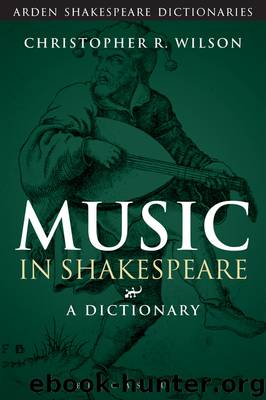Music in Shakespeare by Wilson Christopher R. Calore Michela

Author:Wilson, Christopher R.,Calore, Michela.
Language: eng
Format: epub
Publisher: Bloomsbury UK
As bright Apollo’s lute, strung with his hair.
And when Love speaks, the voice of all the gods
Make heaven drowsy with the harmony.
(LLL 4.3.334; 339–42)
It is not clear from where Shakespeare derived the image of Apollo stringing his lute with his hair (see ‘Apollo’ for a detailed comment), but the idea conjured up by this image is that Apollo and his instrument are inseparable.
The power to calm troubled situations is embodied in Orphic music, particularly Orpheus singing and playing the lute. His lyric verse is his poetic voice; his lute symbolizes his affective music. In The Two Gentlemen of Verona, the two-sided nature of Orpheus’ art, music and poetry, shows that they share in their attempt to bring order and control to worldly things. This is evident from Proteus’ words of advice to Thurio:
For Orpheus’ lute was strung with poets’ sinews,
Whose golden touch could soften steel and stones,
Make tigers tame, and huge leviathans
Forsake unsounded deeps, to dance on sands.
(3.2.77–80)
Only by being in control of both music and poetry will Thurio be able to conquer Silvia.
A similar concept is found in Henry VIII, when one of Queen Katherine’s attendants sings a lute song:
Orpheus with his lute made trees,
And the mountain tops that freeze,
Bow themselves when he did sing.
. . . In sweet music is such art,
Killing care and grief of heart
Fall asleep, or hearing, die.
(3.1.3–5; 12–14)
These words about cosmic balance reflect the Queen’s frustrated desire for harmony in her marriage (she will be ordered to accept Henry’s request for divorce later in the same scene). Katherine’s exhortation to her attendant before the song ‘Take thy lute, wench, my soul grows sad with troubles’ (3.1.1) indicates that a lute was actually played on the stage. This line points to the association between stringed instruments, particularly lutes, and melancholy, especially of those in love.
Similarly, Claudio refers to the sad lute in describing (with a tinge of irony) Benedick’s melancholy, brought on by thwarted love. As a result, his ‘jesting spirit . . . is now / crept into a lute-string, and now govern’d by stops’ (Ado 3.2.59–60).
The calming effect of Orpheus’ music is famously portrayed in the passage towards the end of the The Merchant of Venice (5.1.54–88), reflecting on the ‘sweet power of music’: although obviously intended, Orpheus’ lute is not specifically mentioned.
When Hal compares Falstaff, among other similes, to a ‘lover’s lute’ (1H4 1.2.75), his reference to melancholic symbolism is ambivalent depending on a knowledge of opposites and parody. The lute is a symbol of virtue and calm, happiness and fidelity in love. Its ambivalence lies in its juxtaposition between idealized love and the carnal lusts of the flesh. The lute’s ‘significance as a symbol of vice’,
depends essentially on the idea of parody. Characteristic of evil is its propensity for mocking and perverting the true forms of virtue – something at which Falstaff is notably adept. Thus, although the iconography of the lover’s lute to which Hal compares the melancholy Falstaff may be arcane, its meaning in this context is clear enough. This is plainly no symbol of virtue.
Download
This site does not store any files on its server. We only index and link to content provided by other sites. Please contact the content providers to delete copyright contents if any and email us, we'll remove relevant links or contents immediately.
The Goal (Off-Campus #4) by Elle Kennedy(13542)
Kathy Andrews Collection by Kathy Andrews(11726)
Diary of a Player by Brad Paisley(7487)
What Does This Button Do? by Bruce Dickinson(6133)
Assassin’s Fate by Robin Hobb(6126)
Big Little Lies by Liane Moriarty(5699)
Altered Sensations by David Pantalony(5043)
Pale Blue Dot by Carl Sagan(4907)
Sticky Fingers by Joe Hagan(4100)
The Death of the Heart by Elizabeth Bowen(3551)
The Heroin Diaries by Nikki Sixx(3492)
Beneath These Shadows by Meghan March(3261)
Confessions of a Video Vixen by Karrine Steffans(3240)
How Music Works by David Byrne(3184)
The Help by Kathryn Stockett(3082)
Jam by Jam (epub)(3020)
Harry Potter 4 - Harry Potter and The Goblet of Fire by J.K.Rowling(2984)
Strange Fascination: David Bowie: The Definitive Story by David Buckley(2797)
Petty: The Biography by Warren Zanes(2697)
